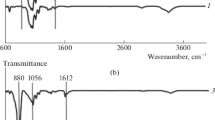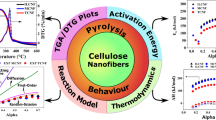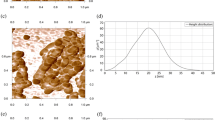Abstract
Inverse gas chromatography (IGC) is a technique for evaluating surface properties. The current work emphasizes the use of IGC to evaluate the surface physicochemical changes during different bacterial cellulose (BC) processing methods as well as upon polyaniline (PANi) incorporation. The processing methods (oven-drying, freeze-drying, and regeneration) caused changes in the BC surface group distribution, where upon freeze-drying and regeneration, a more acidic behavior is obtained, compared to oven-drying (Kb/Ka decreased up to 24%). Through freeze-drying, the structural pore preservation increases (54%) the BC porosity, whereas through regeneration, the porosity decreases (23%), compared to BC oven-drying. Regarding the nanocomposites, with PANi incorporation, the overall properties evaluated by IGC were significantly changed. The \(\gamma_{\text{s}}^{\text{total}}\) increases up to 150%, indicating a more reactive surface in the nanocomposites. Also, is observed a sevenfold increase in the Kb/Ka and a less porous surface (up to 85%). Hence, the current work highlights the use of IGC as a viable technique to evaluate the physicochemical changes upon different BC modifications.





Similar content being viewed by others
References
Alonso E, Faria M, Mohammadkazemi F, Resnik M, Ferreira A, Cordeiro N (2017) Conductive bacterial cellulose-polyaniline nanocomposites: influence of the matrix and synthesis conditions. Carbohydr Polym 183:254–262
Balard H (1997) Estimation of the surface energetic heterogeneity of a solid by inverse gas chromatography. Langmuir 13:1260–1269
Brendlé E, Papirer E (1997) A new topological index for molecular probes used in inverse gas chromatography for the surface nanorugosity evaluation. J Colloid Interface Sci 194:207–216
Calvet R, Confetto S, Balard H, Brendlé E, Donnet J (2012) Study of the interaction of polybutadiene/fillers using inverse gas chromatography. J Chromatogr A 1253:164–170
Castro C, Cordeiro N, Faria M, Zuluaga R, Putaux J, Filpponen I, Velez L, Rojas O, Gañán P (2015) In-situ glyoxalization during biosynthesis of bacterial cellulose. Carbohydr Polym 126:32–39
Conder J (2000) Physicochemical measurements: gas chromatography. In: Cooke M, Poole C (eds) Encyclopedia of separation science. Academic Press, Detroit, pp 3808–3815
Cordeiro N, Gouveia C, Moraes A, Amico S (2011) Natural fibers characterization by inverse gas chromatography. Carbohydr Polym 84:110–117
Ferguson A, Khan U, Walsh M, Lee K, Bismarch A, Shaffer M, Coleman J, Bergin S (2016) Understanding the dispersion and assembly of bacterial cellulose in organic solvents. Biomacromolecules 17:1845–1853
Fowkes F (1964) Attractive forces at interfaces. Ind Eng Chem 56:40–52
Ghazali M, Nawawi M (2000) Diffusion coefficient estimations by thin-channel column inverse gas chromatography: preliminary experiments. Pertan J Sci Technol 8:1–18
Goss K (1997) Considerations about the adsorption of organic moelcules from the gas phase to surfaces: implication for inverse gas chromatography and the prediction of adsorption coefficients. J Colloid Interface Sci 190:241–249
Gutmann V (1978) The donor-acceptor approach to molecular interactions. Springer, New York
Jackson P, Huglin M (1995) Use of inverse gas chromatography to measure diffusion coefficients in crosslinked polymers at different temperatures. Eur Polym J 31:63–65
Kargarzadeh H, Mariano M, Huang J, Lin N, Ahmad I, Alain D, Thomas S (2017) Recent developments on nanocellulose reinforced polymer nanocomposites: a review. Polymer 132:368–393
Missoum K, Belgacem M, Bras J (2013) Nanofibrillated cellulose surface modification: a review. Materials 6:1745–1766
Moon R, Martini A, Nairn J, Simonsen J, Youngblood J (2011) Cellulose nanomaterials review: structure, properties and nanocomposites. Chem Soc Rev 40:3941–3994
Mukhopadhyay P, Schreiber H (1995) Aspects of acid-base interactions and use of inverse gas chromatography. Colloids Surf A Physicochem Eng Asp 100:47–71
Oss V (1988) Interfacial Lifshitz-van der Waals and polar interactions in macroscopic system. Chem Rev 88:927–941
Riddle F, Fowkes F (1990) Spectral shifts in acid-base chemistry. 1—Van der Waals contributions to acceptor numbers. J Am Soc 112:3259–3264
Schultz J, Lavielle L, Martin C (1987) The role of the interface in carbon-fibre epoxy composites. J Adhes 23:45–60
Sen A (2005) Inverse gas chromatography. Defense Scientific Information & Documentation Centre, New Delhi
Thielmann F (2004) Introduction into the characterization of porous materials by inverse gas chromatography. J Chromatogr A 1037:115–123
Voelkel A, Strzemiecha B, Adamska K, Milczewska K (2009) Inverse gas chromatography as a source of physiochemical data. J Chromatogr A 1216:1551–1566
Walton K, Snurr R (2007) Applicability of the BET method for determining surface areas of microporous metal-organic frameworks. J Am Chem Soc 129:8552–8556
Wang H, Zhu E, Yang J, Zhou P, Sun D, Tang W (2012) Bacterial cellulose nanofiber-supported polyaniline nanocomposites with flake-shaped morphology as supercacitor electrodes. J Phys Chem 116:13013–13019
Acknowledgments
The authors would like to thank the Programa Nacional de Re-equipamento Científico, POCI 2010, for sponsoring IGC work (FEDER and Foundation for Science and Technology). Moreover, the help of Tomásia Fernandes and Igor Fernandes (Madeira University) in the laboratory work was appreciated.
Author information
Authors and Affiliations
Corresponding author
Electronic supplementary material
Below is the link to the electronic supplementary material.
Rights and permissions
About this article
Cite this article
Alonso, E., Faria, M., Ferreira, A. et al. Influence of the matrix and polymerization methods on the synthesis of BC/PANi nanocomposites: an IGC study. Cellulose 25, 2343–2354 (2018). https://doi.org/10.1007/s10570-018-1736-0
Received:
Accepted:
Published:
Issue Date:
DOI: https://doi.org/10.1007/s10570-018-1736-0




